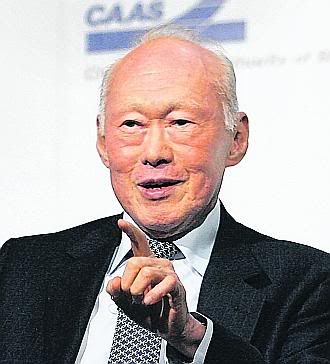STOP THE WAYANG, just return us our CPF!
July 22, 2009 by admin
Filed under: Current Affairs
Written by Ng E-Jay
22 July 2009
More twist and turns have appeared in the CPF Life scheme, an annuity scheme to be administered by the CPF Board that promises to give lifelong payouts to CPF members.
On Monday in Parliament, Manpower Minister Gan Kim Yong found himself clumsily trying to reassure Singaporeans that monthly payouts from the CPF Life scheme will continue as long as the CPF member is alive, despite a provision allowing the CPF Board to stop payments in the event that the Lifelong Income Fund becomes insolvent.
Madam Halimah, chairman of the Government Parliamentary Committee for Manpower, had earlier noted that she found this clause “quite disturbing“.
Mdm Halimah has a curious sense of humour and a vocabulary to match. This clause is not merely disturbing. It is monstrous because it allows the Government to completely shirk its responsibility and accountability to Singaporeans in the event that the Lifelong Income Fund becomes insolvent due to its mismanagement and incompetence.
To Mdm Halimah’s credit, she did note that while similar clauses exist for commercial insurance companies, “the relationship between the CPF Board and the CPF members, however, is not just a legal contract (but) a social contract as the board has a social responsibility to manage CPF funds prudently in order to help Singaporeans meet their retirement needs.” (Straits Times, “CPF Life payouts to be lifelong: Minister“, 21 July 2009.)
MPs Madam Halimah Yacob (Jurong GRC) and Madam Ho Geok Choo (West Coast GRC) also expressed concern about the lack of guarantee on premiums and payouts, which they argued gave the Government too much discretion.
Mr Gan tried to ally all these concerns by repeating the tired refrain that the fund would be managed on sound actuarial principles, and that it was not feasible to guarantee the amount paid because monthly payouts have to be adjusted according to changes in prevailing interest rates and mortality in order to maintain the solvency of the scheme.
However, without any transparency as to how to Lifelong Income Fund is managed, Mr Gan’s tepid reassurances give little comfort.
We have just witnessed how Temasek and GIC lost billions in the recent financial meltdown as a result of dubious investments in foreign financial institutions. Without adequate disclosure or transparency, and without the ability to hold Temasek and GIC accountable to the general public, no one knows how big a hole they have truly dug for themselves and exactly how much taxpayers’ money has gone down the drain due to mismanagement.
With similar lack of transparency and accountability in the CPF Life scheme and the way the Lifelong Income Fund is managed, can the same happen to CPF members’ hard-earned savings?
With so much at stake, it is time for Singaporeans to stand up and demand that the ruling PAP stop creating new schemes to hold back their life savings in order to plug the holes of the sinking ship that is the CPF. It is time to ask the Government to stop the wayang, and return us our CPF.
July 22, 2009 by admin
Filed under: Current Affairs
Written by Ng E-Jay
22 July 2009
More twist and turns have appeared in the CPF Life scheme, an annuity scheme to be administered by the CPF Board that promises to give lifelong payouts to CPF members.
On Monday in Parliament, Manpower Minister Gan Kim Yong found himself clumsily trying to reassure Singaporeans that monthly payouts from the CPF Life scheme will continue as long as the CPF member is alive, despite a provision allowing the CPF Board to stop payments in the event that the Lifelong Income Fund becomes insolvent.
Madam Halimah, chairman of the Government Parliamentary Committee for Manpower, had earlier noted that she found this clause “quite disturbing“.
Mdm Halimah has a curious sense of humour and a vocabulary to match. This clause is not merely disturbing. It is monstrous because it allows the Government to completely shirk its responsibility and accountability to Singaporeans in the event that the Lifelong Income Fund becomes insolvent due to its mismanagement and incompetence.
To Mdm Halimah’s credit, she did note that while similar clauses exist for commercial insurance companies, “the relationship between the CPF Board and the CPF members, however, is not just a legal contract (but) a social contract as the board has a social responsibility to manage CPF funds prudently in order to help Singaporeans meet their retirement needs.” (Straits Times, “CPF Life payouts to be lifelong: Minister“, 21 July 2009.)
MPs Madam Halimah Yacob (Jurong GRC) and Madam Ho Geok Choo (West Coast GRC) also expressed concern about the lack of guarantee on premiums and payouts, which they argued gave the Government too much discretion.
Mr Gan tried to ally all these concerns by repeating the tired refrain that the fund would be managed on sound actuarial principles, and that it was not feasible to guarantee the amount paid because monthly payouts have to be adjusted according to changes in prevailing interest rates and mortality in order to maintain the solvency of the scheme.
However, without any transparency as to how to Lifelong Income Fund is managed, Mr Gan’s tepid reassurances give little comfort.
We have just witnessed how Temasek and GIC lost billions in the recent financial meltdown as a result of dubious investments in foreign financial institutions. Without adequate disclosure or transparency, and without the ability to hold Temasek and GIC accountable to the general public, no one knows how big a hole they have truly dug for themselves and exactly how much taxpayers’ money has gone down the drain due to mismanagement.
With similar lack of transparency and accountability in the CPF Life scheme and the way the Lifelong Income Fund is managed, can the same happen to CPF members’ hard-earned savings?
With so much at stake, it is time for Singaporeans to stand up and demand that the ruling PAP stop creating new schemes to hold back their life savings in order to plug the holes of the sinking ship that is the CPF. It is time to ask the Government to stop the wayang, and return us our CPF.




